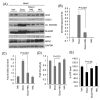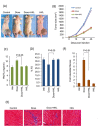Honokiol, an activator of Sirtuin-3 (SIRT3) preserves mitochondria and protects the heart from doxorubicin-induced cardiomyopathy in mice
- PMID: 28423723
- PMCID: PMC5470953
- DOI: 10.18632/oncotarget.16133
Honokiol, an activator of Sirtuin-3 (SIRT3) preserves mitochondria and protects the heart from doxorubicin-induced cardiomyopathy in mice
Abstract
Doxorubicin is the chemotherapeutic drug of choice for a wide variety of cancers, and cardiotoxicity is one of the major side effects of doxorubicin treatment. One of the main cellular targets of doxorubicin in the heart is mitochondria. Mitochondrial sirtuin, SIRT3 has been shown to protect against doxorubicin-induced cardiotoxicity. We have recently identified honokiol (HKL) as an activator of SIRT3, which protects the heart from developing pressure overload hypertrophy. Here, we show that HKL-mediated activation of SIRT3 also protects the heart from doxorubicin-induced cardiac damage without compromising the tumor killing potential of doxorubicin. Doxorubicin-induced cardiotoxicity is associated with increased ROS production and consequent fragmentation of mitochondria and cell death. HKL-mediated activation of SIRT3 prevented Doxorubicin induced ROS production, mitochondrial damage and cell death in rat neonatal cardiomyocytes. HKL also promoted mitochondrial fusion. We also show that treatment with HKL blocked doxorubicin-induced cardiac toxicity in mice. This was associated with reduced mitochondrial DNA damage and improved mitochondrial function. Furthermore, treatments of mice, bearing prostrate tumor-xenografts, with HKL and doxorubicin showed inhibition of tumor growth with significantly reduced cardiac toxicity. Our results suggest that HKL-mediated activation of SIRT3 protects the heart from doxorubicin-induced cardiotoxicity and represents a potentially novel adjunct for chemotherapy treatments.
Keywords: Cardiac hypertrophy; Pathology Section; SIRT3; cancer therapy; cardiac toxicity; doxorubicin.
Conflict of interest statement
The authors declare that they have no conflicts of interest with the contents of this article.
Figures









Similar articles
-
Sirt3 protects mitochondrial DNA damage and blocks the development of doxorubicin-induced cardiomyopathy in mice.Am J Physiol Heart Circ Physiol. 2016 Apr 15;310(8):H962-72. doi: 10.1152/ajpheart.00832.2015. Epub 2016 Feb 12. Am J Physiol Heart Circ Physiol. 2016. PMID: 26873966 Free PMC article.
-
Honokiol blocks and reverses cardiac hypertrophy in mice by activating mitochondrial Sirt3.Nat Commun. 2015 Apr 14;6:6656. doi: 10.1038/ncomms7656. Nat Commun. 2015. PMID: 25871545 Free PMC article.
-
Sirtuin-3 (SIRT3) Protein Attenuates Doxorubicin-induced Oxidative Stress and Improves Mitochondrial Respiration in H9c2 Cardiomyocytes.J Biol Chem. 2015 Apr 24;290(17):10981-93. doi: 10.1074/jbc.M114.607960. Epub 2015 Mar 10. J Biol Chem. 2015. PMID: 25759382 Free PMC article.
-
Doxorubicin induced cardio toxicity through sirtuins mediated mitochondrial disruption.Chem Biol Interact. 2022 Sep 25;365:110028. doi: 10.1016/j.cbi.2022.110028. Epub 2022 Jul 31. Chem Biol Interact. 2022. PMID: 35921947 Review.
-
Sirtuin-3 Regulates the Mechanism of Doxorubicin-induced Cardiotoxicity.Int Heart J. 2025 Jul 31;66(4):527-539. doi: 10.1536/ihj.24-546. Epub 2025 Jul 9. Int Heart J. 2025. PMID: 40634060 Review.
Cited by
-
Targeting mitochondrial dynamics proteins for the treatment of doxorubicin-induced cardiotoxicity.Front Mol Biosci. 2023 Aug 3;10:1241225. doi: 10.3389/fmolb.2023.1241225. eCollection 2023. Front Mol Biosci. 2023. PMID: 37602332 Free PMC article. Review.
-
Actinidia chinensis planch polysaccharide protects against hypoxia‑induced apoptosis of cardiomyocytes in vitro.Mol Med Rep. 2018 Jul;18(1):193-201. doi: 10.3892/mmr.2018.8953. Epub 2018 May 3. Mol Med Rep. 2018. PMID: 29750308 Free PMC article.
-
The Neolignan Honokiol and Its Synthetic Derivative Honokiol Hexafluoro Reduce Neuroinflammation and Cellular Senescence in Microglia Cells.Cells. 2024 Oct 4;13(19):1652. doi: 10.3390/cells13191652. Cells. 2024. PMID: 39404415 Free PMC article.
-
Role of Reactive Oxygen Species in Cancer Progression: Molecular Mechanisms and Recent Advancements.Biomolecules. 2019 Nov 13;9(11):735. doi: 10.3390/biom9110735. Biomolecules. 2019. PMID: 31766246 Free PMC article. Review.
-
Nano-drug co-delivery system of natural active ingredients and chemotherapy drugs for cancer treatment: a review.Drug Deliv. 2022 Dec;29(1):2130-2161. doi: 10.1080/10717544.2022.2094498. Drug Deliv. 2022. PMID: 35815678 Free PMC article. Review.
References
MeSH terms
Substances
Grants and funding
LinkOut - more resources
Full Text Sources
Other Literature Sources
Medical
Molecular Biology Databases

